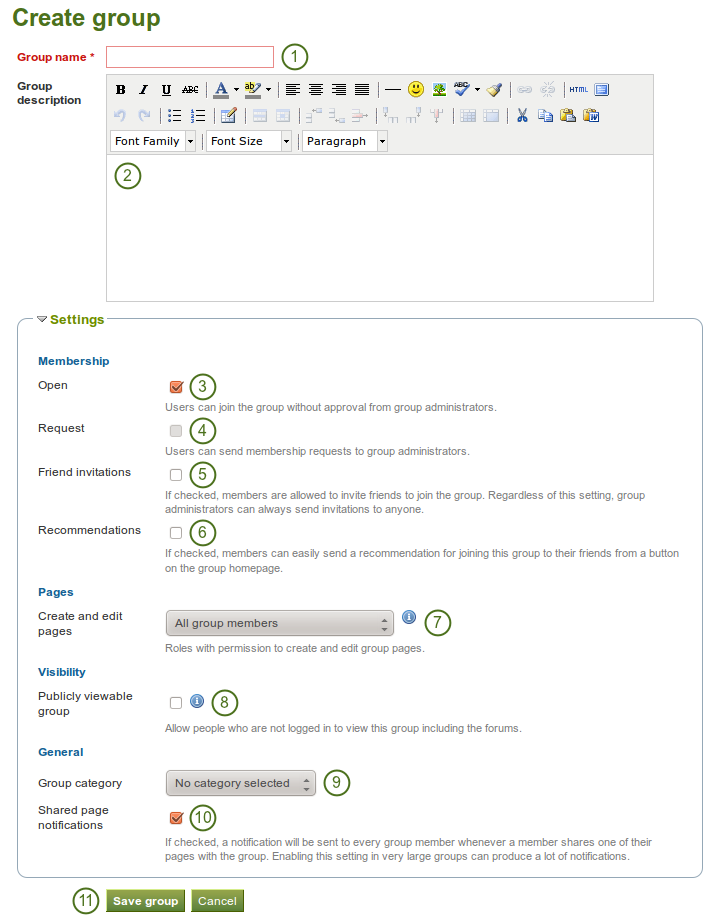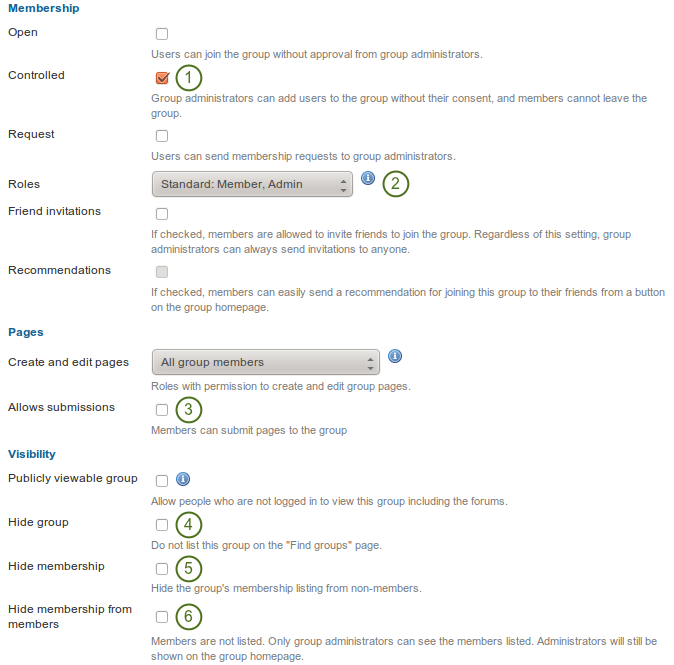5.3. Set up a group¶
Groups → My groups → Create group
You can create different groups depending on your role.
All users
- Open membership: Any user of the site can become a member simply by visiting your group page and clicking the Join button.
- Request membership Any user can request to join your group. However, as owner you can choose to accept or decline this request. The requesting member will be notified of your decision automatically.
Staff and administrators in addition: Controlled membership
- You can add users directly to your group.
- The members cannot leave this group.
- You can assign tutors to the group. They can add new members.
- Group members can submit portfolio pages for feedback / assessment. These pages are locked until released by an administrator or tutor.
Notitie
The site administrator can limit the creation of groups to users with staff and / or administrator rights. If you cannot create a group, you will most likely not have the appropriate permission and will have to contact your site administrator, e.g. via the Contact us form to enquire about the process of having a group set up.
5.3.1. Create a group as a user¶
If you are allowed to create a group, you see the Create group button on the My groups overview page.

Create a group as a user
- Group name: Provide a name for your group. This field is mandatory.
- Group description: Briefly describe what your group is about.
- Open: Create an open membership group if you want users to join the group without approval from group administrators.
- Request: Create a request membership group if you want user to send membership requests to group administrators. Open and request membership groups are mutually exclusive.
 Friend invitations: Check this box if you want to allow members to invite friends to join the group. Regardless of this setting, group administrators can always send invitations to anyone.
Friend invitations: Check this box if you want to allow members to invite friends to join the group. Regardless of this setting, group administrators can always send invitations to anyone. Recommendations: Check this box if you want to allow members to send a recommendation for joining this group to their friends from a button on the group homepage. Friend invitations and recommendations are mutually exclusive options.
Recommendations: Check this box if you want to allow members to send a recommendation for joining this group to their friends from a button on the group homepage. Friend invitations and recommendations are mutually exclusive options. Create and edit pages: Decide who shall be able to create and edit pages in the group:
Create and edit pages: Decide who shall be able to create and edit pages in the group:- All group members
- Everyone except ordinary members, i.e. group administrators and tutors depending on the group type
- Group administrators only
- Publicly viewable group: Choose this option if anybody shall have access to this group. You only see this setting if the site administrator allowed you to have it. Anybody can see the group homepage and the discussion forum. Depending on the membership visibility, they may also see group members. Only members of the groups can see the group’s pages, unless they have been made public, and the files area.
- Group category: Choose a category if you want to associate your group to one, allowing you to filter groups on the My groups and Find groups page according to categories. This setting is only available if the site administrator turned it on.
- Shared page notification: This check box has a check mark per default. Whenever somebody shares a page with the group, all group members receive a notification. You may want to uncheck this setting in very large groups where lots of pages are shared but members do not have to be notified.
- Click the Save group button to finish creating your group, or click the Cancel button to abort the group creation process.
Notitie
The group name that you choose does not have to be unique. Other groups can have the same name. In order to distinguish them more easily, you can add a group description.
5.3.2. Create a group as staff member or institution admin¶
In addition to the group settings that a regular user has, institution staff and administrators have a few more options.

Additional options for staff and institution administrators
- Controlled: Create a controlled group if you wish to add users who cannot leave the group. This is a useful setting for course groups where you do not want members to leave.
- Roles: Choose whether you have only members and administrators or also tutors. The latter can provide feedback and release pages when page submissions are allowed, but they cannot change group settings.
- Allow submissions: Use this option to allow group members to submit pages for feedback / assessment. These pages and a number of artefacts in them are locked until released by a group admin or tutor.
 Hide group: Use this option to not list this group on the Find groups page.
Hide group: Use this option to not list this group on the Find groups page. Hide membership: Use this option to hide the group’s membership listing from non-members.
Hide membership: Use this option to hide the group’s membership listing from non-members. Hide membership from members: Use this option to hide the group’s membership listing from members as well. Only group administrators can see the members listed. Administrators are still shown on the group homepage.
Hide membership from members: Use this option to hide the group’s membership listing from members as well. Only group administrators can see the members listed. Administrators are still shown on the group homepage.
5.3.3. Create a group as a site admin¶
When you have site administrator rights, you have yet another additional setting when you create a group: You can choose to add new users to a group automatically. That way, any new user on the site becomes a member of this group.

Add users to a group automatically
Notitie
This is a great setting when you want to set up a community group which all users should join in order to participate in forum discussions etc. On mahara.org this is used to make every user a member of the “Community” group in which discussions around Mahara take place.
5.3.4. Edit general group settings¶
You can start out editing a group’s settings from three places by clicking on the Edit button:
- My groups page
- Find groups page
- The group homepage
You are then taken to the same screen as if you were creating a group and make the necessary changes.
Waarschuwing
You can change the group type to a different one. Please be careful if you do so especially from a controlled course group. If users have submitted portfolio pages to that group, they remain locked when you change the group type.